MILLSTONES
SMALL HOME GRINDERS
Grain could be ground by hand using a mortar
and pestle or a quern . A mortar is a deep bowl and a pestle is
a heavy club used to pound the grain inside the mortar. A quern
was a device with two stones held on a large barrel. The stone
on top was turned using a handle as the grain was poured into
the center of the top stone. Both these hand methods were very
difficult.
Gristmills were build to reduce the amount
of work done by individual farmers. Grist means "grain"
and a mill grinds.
MILLSTONES
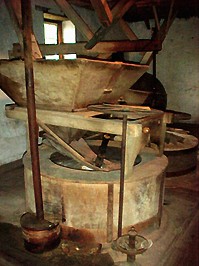 |
On the first floor of the mill were
the French Burh millstones that were used for grinding grain.
The millstones weigh one ton each. Each stone was dressed for
its particular purpose and used in a pair. The grain was crushed
between a set of stones called millstones.
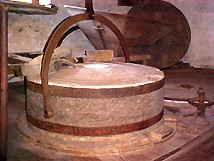
|
The bottom stone was a bedstone and the
top stone was the called the runner. A stone spindle passed through
a whole in the center of the stone and made it turn. The distance
between the stone was determined by the kind of grain being ground.
The stones never touched.
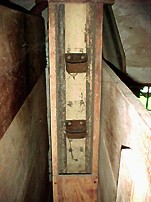 |
Feed or
grain was elevated using an elevator. Small metal cups fastened
on a chain or leather belt enclosed in a wooden case (a hollow
post or elevator leg) moved the grain up to the top of the mill.
The elevator threw the grain out of the cups and into a spout
that went to a bin on the floor below. Gravity was used to lower
the grain onto the millstones for grinding. |
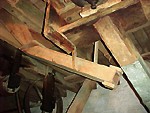 |
Grain in a bin on the
third floor came down a wooden chute into a large funnel called
the hopper. |
|

View of eye of runner from above set of stones.
|
The hopper sent the
grain through a whole called an eye in the center of the runner
(top stone -two views seen here). |

View of eye of runner from below.
|
| The surface
of the stone had flat areas called "land" and a series
of grooves called "furrows." The furrows ripped off
the outer husk, sent the flour to the outside of the wheel, and
allowed air to pass through the stones to reduce the heat created
by grinding. |
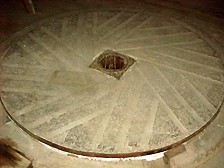
Bedstone
|
| Millstones were dressed
every few weeks. Mill picks were used for this job. |
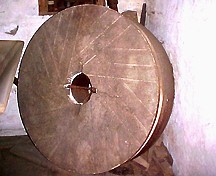
Runner stone |







